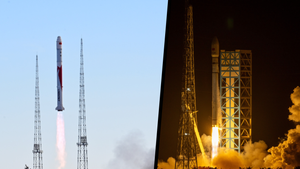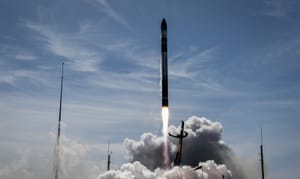
At 03:47 am Universal Coordinated Time on August 16th, India launched its third development flight for its SSLV launch vehicle. This third, and final, development flight flew from the Satish Dhawan Space Centre.
Atop of SSLV for this launch was the EOS-08 satellite, a small 175.5 kilogram Earth observation satellite. EOS-08 also has new domestic technologies onboard, such as flexible solar panels. According to the Indian Space Research Organisation, the three payloads of EOS-08 are:
- EOIR, Electro Optical Infrared Payload, is designed to image in mid-wave and long-wave infrared spectrums to provide satellite-based surveillance, disaster monitoring, and environmental monitoring.
- GNSS-R, Global Navigation Satellite System-Reflectometry payload, is designed to demonstrate GNSS-R based remote sensing in applications such as ocean surface winds, soil moisture, cryosphere applications over the Himalayan Region, and flood detection.
- SiC UV Dosimeter is a demonstration payload to monitor Ultraviolet radiation for eventual use on the crewed Gaganyaan spacecraft, the payload will also test a high dose alarm.

After separating from the launch vehicle, EOS-08 is believed to be in a 475-kilometer orbit, on a 37.4 degree inclination. A tiny 200-gram satellite called SR-O DEMOSAT, developed by Space Kidz India, was also onboard and deployed minutes after EOS-08.
Speaking after the successful deployment of both satellites, Chairman of the Indian Space Research Organisation, S. Somanath, said:
"The rocket has placed the satellites into precise orbit. With this, we declare that the SSLV development process is completed." – "With the successful launch, ISRO is moving into the operation phase of SSLV."
Once the operational phase begins, the agency expects SSLV to be a low-cost fast-turnaround launch vehicle offering both rideshare and dedicated launch to low Earth orbit or sun-synchronus orbit. SSLV had been performing development flights since August of 2022, with two successful missions occurring out of three flights.
This launch of SSLV on August 16th also ended a seven-month orbital launch hiatus from India, as its last launch was performed by GSLV on February 17th 2024.
What is SSLV?
Small Satellite Launch Vehicle, commonly called SSLV, is a small-lift launch vehicle operated by the Indian Space Research Organisation. SSLV can lift up to 500 kilograms to low Earth orbit or 300 kilograms to sun-synchronous orbit.

SSLV uses four stages to deliver its payloads to orbit. The first stage consists of a large solid rocket motor that burns hydroxyl-terminated polybutadiene and generates 255 tons of thrust. The second stage is another solid rocket motor that burns Hydroxyl-terminated polybutadiene and generates 24 tons of thrust. The third stage is SSLV's final solid rocket motor, which burns Hydroxyl-terminated polybutadiene and generates 16 tons of thrust. The fourth and final stage is known as the Velocity Trimming Module, and it is propelled by two bipropellant thrusters that produce 10 kilograms of thrust using Monomethylhydrazine and Mixed oxides of nitrogen as liquid fuel.
On the launchpad, SSLV stands at a height of 34 meters tall, with a weight of approximately 120,000 kilograms.



